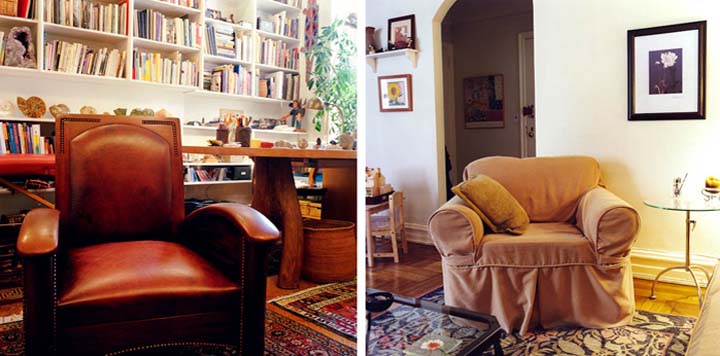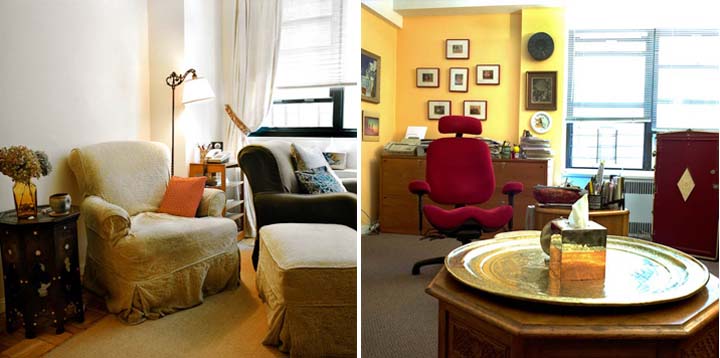Saul Robbins | Initial Intake
With Initial Intake, a series of images of the chairs and office surroundings of Manhattan-based psychotherapists, photographer Saul Robbins turns the table on a time-honored process. His camera stands in for the person being examined; his photographs assess the analyst, based on his/her chair, the overall setting, and most compellingly, through small touches that speak volumes. A selection of images from the series goes on view Thursday at the Griffin Museum of Photography. I caught up with Saul last week for this email Q&A.
Peggy Roalf: What was the first photograph you made in this series and how did it come about?
Saul Robbins: The first photograph I made was in the office of the psychotherapist I was seeing at the time, on the Upper West Side, and came about from a variety of influences and considerations. At the time I had been photographing the implied meanings of gestures and small still-life-like settings found amongst my family and friends, including a dollhouse in someone’s office. I was attracted especially to the incredible dynamism and beauty of these quotidian actions and environments.
I was also beginning to actively question the visual implications of my psychotherapist’s chair and office surroundings, as signifiers for the banality and lifelessness of many of our sessions, and my own frustration with seeing him. While we did some good work together—and one should choose a practitioner based on qualification, not office décor—that office was so dull and lifeless, so devoid of vitality, as if those qualities should not infringe upon our sessions.
For example, a few times there were dead flowers in a vase that he wouldn’t throw away because a colleague who shared the office with him had brought them in. I began to see this as a reflection on his personality, and perhaps his qualifications. Sitting across from him each week, I wondered what would his chair seem like if empty; wondering, would I miss his absence? And so I asked if I could photograph his empty chair.

Left: Upper West Side, 2004. Right: Upper East Side, 2008.
PR: What were you attempting to bring out in such a detailed exploration of these small spaces? What were you trying to get at by presenting such a range of comparisons—from somewhat shabby to quite sophisticated?
SR: I was never trying to overtly formulate a critique of people’s offices, to compare decorative and organizational styles. Rather, I hoped to stimulate viewers’ awareness as my own had matured with my practitioner; and to reference peoples’ perceptions, associations, and responses to these extremely private environments and the work that takes place there.
That some are shabby and some quite chic, I think, reflects more the variety of importance and awareness these psychotherapists have, and bring, to such details. Personally I am more interested in the existence and importance of a dyadic relationship between practitioner and client. So given what I just said about that first practitioner, this work is much more about that confrontation with disappointment, about wanting greater connection and interaction with others.
PR: One of the offices clearly seems to be someone’s personal living space. This seems a bit unprofessional, even off-putting—would you agree?
SR: Yes and no. Freud and many others worked out of their home offices and still do. I think the problem you are getting at is how well do these practitioners differentiate their office environment from that of their home. That was the premise for the article that Penelope Green wrote for The New York Times “House and Home” section featuring my work, and I think she did an excellent job considering and bringing this to readers’ attention.
PR: How did you find your subjects for this extended series?
SR: My access was mostly through word of mouth and personal networks in Manhattan. The first chair belonged to my psychotherapist at the time. Chairs 2, 3, and 4 belonged to friends of my aunt and uncle who I have spent every Erev Rosh Hashanah dinner with since moving to New York, and to the mentor of a friend from Synagogue. I met one of the practitioners while waiting for jury duty, others in elevators and on the bus, through friends in Synagogue—I love Jewish geography—and there were several friends, students, acquaintances, and other psychotherapists whose psychotherapists and colleagues were happy to let me contact them.
As I added the series to my website, I included a short link inviting practitioners to contact me if they wanted to participate. I also offered them a free small proof print in exchange, which stimulated many interesting comments afterwards.
PR: Did you turn down any offices that were offered? If so, for what reasons?
SR: The only offices I didn’t photograph were the ones I couldn’t get access to, after making contact by phone. This happened a few times because of scheduling, loss of interest, etc., but my favorite memory is of speaking with a very nice practitioner who expressed her concerns about anonymity by saying that she would never risk her clients finding her chair in The New York Times, a possibility considered by some to be a breach of confidentiality, which I respect. When she said this (it was early in the project), I laughed to myself, not out of any disrespect but just thinking, “Don’t worry lady, that never happens to me.” However, when The Times arrived at our door with my work wrapped around the front section, as they used to do sometimes, that call came to mind immediately, and I thought how prescient she was.

Left: Columbus Circle, 2008. Right: Upper East Side, 2008
PR: Did your arrangements include showing your photographs to the psychotherapists for permission to use?
SR: No. When I began photographing I wrote a simple model release, promising complete confidentiality and anonymity in exchange for participation in this project. I was immediately upfront about my intentions and possible uses for this work—exhibition, publication, Web/Internet, etc.—so if a practitioner was uncomfortable signing my release I would thank them for their time on the phone and that was it.
PR: Did you use any artistic devices to enhance the feeling of a power relationship in any of the images?
SR: The only criteria for locating my camera was that it be situated at eye level above the client’s chair. The first thing I did after introducing myself was to sit in that chair for 5 to 10 minutes, until I had a strong sensation of what was visible from this perspective. Then, since I photographed with a square format and a medium wide-angle lens, I would pan and tilt my tripod to capture enough variety in point of view so as not miss anything nor locate the chair dead center in each image, which rarely happened visually in these offices.
PR: One of the photographs shows a dog in residence in the office. To me this seems like a total power play; what if a client doesn’t like dogs, or the doggy odor that must be afloat?
SR: While I would have agreed with you before photographing the first pet owner’s office—there are at least two—when I spoke with these practitioners, they were very aware of that possibility, but spoke so convincingly about the sensitivity of their dogs to their clients’ changing emotional states and the value of a “positive transference” taking place between client and animal. As a child, I was very close to our dog and cat, actually practiced my French when we went for walks at night in San Francisco, and as we know, pets are increasingly accepted as substitutes for children and partners, so the profundity of their comments and observations seems as relevant as it is fascinating.
PR: When you did the How Can I Help | An Artful Dialogue project, what was the most interesting story told by a visitor about his/her reaction to a psychotherapist’s office?
SR: Actually, there haven’t been that many outrageous stories about other peoples’ psychotherapists’ offices. Most people like to complain about the bad decor of their psychotherapists’ office, how it matches, or clashes with their personality, noticing how they have changed something, etc. When people look at my photographs, more often they comment on how certain neighborhoods typify their expectations of that neighborhood and who might practice there.
PR: Having become so schooled in the arrangement and finish of these spaces, has your own living and work space changed very much as a result? In what way?
SR: Unfortunately, not as much as I might like. My wife and I try to keep most of our apartment organized even though I work at home and that room is the one that remains chaotic as a workroom. However, equally important as how our flat looks, is how it “feels” and functions as an environment for entertaining, work, and as the place to restore ourselves each day apart from the maelstrom of New York City outside our door.
Saul Robbins | Initial Intake,
opening reception and artist talk, Thursday, January 31, 6-7:30 pm. The Griffin
Museum Atelier Gallery at the Stoneham Theatre, 395 Main Street, Stoneham, MA. A catalogue of the exhibition is available.


